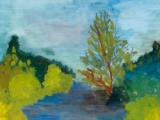Processing logs into wood was very hard work before the steam and
petrol tools and saws were invented.
Chopping trees with an axe was the
easiest of all the forester work. The work had to be handled manually.
The logs had to be sawed, which lasted
a few days.
Today most work is done by machines.
Today foresters can saw logs quickly
although they are enormous, because they use chain saws and then they chain them up with
big hydraulic tongs and put them on a truck which safely takes logs to sawmill.
Floating logs on water was a
traditional and a cheap way to transport wood to sawmills. Setting logs free was dangerous
and it demanded great skills and balance. This procedure was used a lot in North America
and Scandinavia. In Slovenia it was used on the river Savinja. Today floating is used only
for tourism.
In the mountains, where logs
couldn’t be put into water, workers built water runways, where they put logs and sent
them downhill.
A telepher line was often used to
transport the logs from high places to the valley.
Idrijske klavže enabled a special way of
storing logs and is still considered a great technical achievement of that time and it is
an important cultural technical monument nowadays. |

